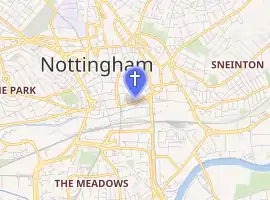St. John the Baptist's Church, Leenside, Nottingham
The church of St. John the Baptist, Leenside, Nottingham was opened in 1844 as a parish church in the Church of England. It was destroyed in 1941.
| St. John the Baptist's Church, Leenside, Nottingham | |
|---|---|

| |
| Country | United Kingdom |
| Denomination | Church of England |
| Churchmanship | Anglo Catholic |
| History | |
| Dedication | St. John the Baptist |
| Architecture | |
| Architect(s) | George Gilbert Scott |
| Style | Early English Period |
| Completed | 1844 |
| Construction cost | £4,400 |
| Closed | 1941 |
| Administration | |
| Parish | Nottingham |
| Diocese | Diocese of Southwell |
| Province | York |
History
The foundation stone for the church of St. John the Baptist was laid by Charles Pierrepont, 2nd Earl Manvers on 9 August 1843 and an address was delivered to the onlookers by Archdeacon George Wilkins. It was created out of the parish of St. Mary's Church, Nottingham. The architects were George Gilbert Scott and William Bonython Moffatt.[1] The Church Building Commission gave a grant of £800 towards the cost of its construction.[2]
The church was dedicated by Rt. Revd. John Kaye, Bishop of Lincoln on 5 November 1844.[3] It had seating for 800 people and cost £4,400. (equivalent to £443,290 in 2019),[4]
It was built in the Early English Period style in Bulwell stone. The dressings were from quarries at Cromford, Coxbench and Duffield, Derbyshire. The pier capitals were from Mansfield. The parsonage house was built in 1850-51 to the designs of local architect Francis Williamson.
The first incumbent was William Howard 1840 – 1853. Afterwards he became Rector of St Peter's Church, Nottingham. Howard was succeeded by John Montague Valpy in 1853.[5] During the incumbency of Valpy, St. John's was the first church in Nottingham to introduce a surpliced choir and choral and week-day celebrations of the Eucharist.[6] Although it was designed for the poor working-class people in the Leenside area of Nottingham, its High Church churchmanship soon attracted a more wealthy middle class congregation from The Park.[7]
In 1911 the Extra Parochial area of St. James' Church, Standard Hill was added to it.
It was bombed in a Second World War air raid during the Nottingham Blitz on 8–9 May 1941 and later demolished. The parish was joined with that of St George in the Meadows, Nottingham.
Official History via Southwell Diocese
Further details of the history of this church, as well as a graphic picture of the aftermath of its tortuous end, can be found via the Churches of Southwell official web portal.
References
- An itinerary of Nottingham. J. Holland Walker. 1935
- Port, M. H. (2006), 600 New Churches: The Church Building Commission 1818-1856 (2nd ed.), Reading: Spire Books, p. 340, ISBN 978-1-904965-08-4
- The Gentleman's magazine, Volume 177
- UK Retail Price Index inflation figures are based on data from Clark, Gregory (2017). "The Annual RPI and Average Earnings for Britain, 1209 to Present (New Series)". MeasuringWorth. Retrieved 2 February 2020.
- The Clergy List. 1866
- The Anglican Church in the Industrialised Town. St. Mary's Parish, Nottingham. 1770-1884. M.W. Bowen. Dissertation. University of Nottingham. 1997
- A Centenary History of Nottingham. John Beckett. p.358. Manchester University Press. 1997
